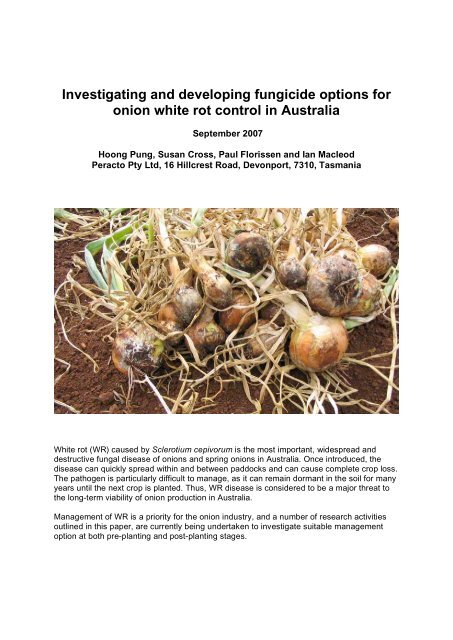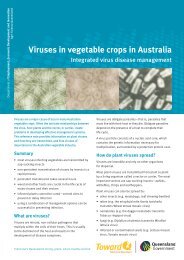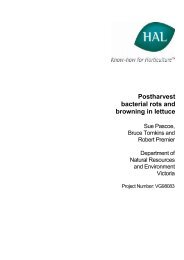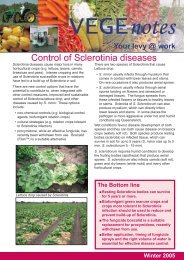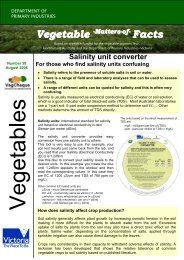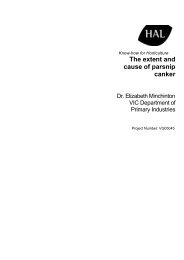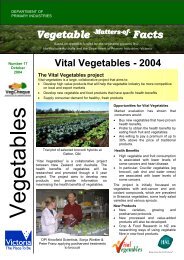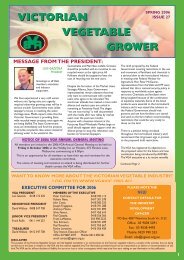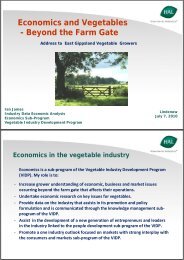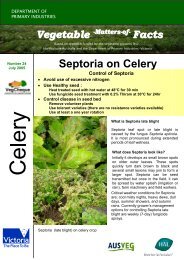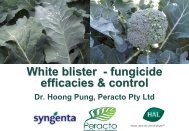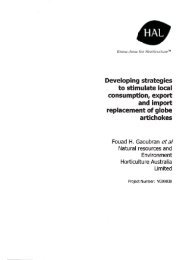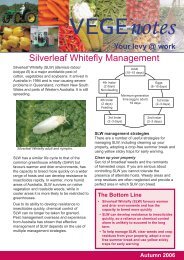Onion white rot control - Peracto
Onion white rot control - Peracto
Onion white rot control - Peracto
Create successful ePaper yourself
Turn your PDF publications into a flip-book with our unique Google optimized e-Paper software.
Investigating and developing fungicide options for<br />
onion <strong>white</strong> <strong>rot</strong> <strong>control</strong> in Australia<br />
September 2007<br />
Hoong Pung, Susan Cross, Paul Florissen and Ian Macleod<br />
<strong>Peracto</strong> Pty Ltd, 16 Hillcrest Road, Devonport, 7310, Tasmania<br />
White <strong>rot</strong> (WR) caused by Scle<strong>rot</strong>ium cepivorum is the most important, widespread and<br />
destructive fungal disease of onions and spring onions in Australia. Once introduced, the<br />
disease can quickly spread within and between paddocks and can cause complete crop loss.<br />
The pathogen is particularly difficult to manage, as it can remain dormant in the soil for many<br />
years until the next crop is planted. Thus, WR disease is considered to be a major threat to<br />
the long-term viability of onion production in Australia.<br />
Management of WR is a priority for the onion industry, and a number of research activities<br />
outlined in this paper, are currently being undertaken to investigate suitable management<br />
option at both pre-planting and post-planting stages.
1. Post-plant fungicide applications<br />
Fungicide options for <strong>white</strong> <strong>rot</strong> are currently limited and identification of alternative fungicides<br />
for commercial use on onions is seen as a priority for the onion industry in Australia.<br />
Additionally, application methods for delivering fungicides to the onion bulb and roots are<br />
vital, and yet have been very difficult to achieve. As such, research being conducted by<br />
<strong>Peracto</strong> Pty Ltd aims to evaluate and develop effective fungicide treatments and application<br />
methods for <strong>white</strong> <strong>rot</strong> <strong>control</strong>.<br />
In 2006 and 2007, five trials were conducted in Queensland and Tasmania to compare the<br />
efficacies of fungicides with early and late applications for WR <strong>control</strong>. Conducted within<br />
commercial onion and spring onion crops, the data from these trials was analysed and a<br />
detailed report on each trial completed.<br />
Method<br />
Evaluations of the following fungicide products were included: Amistar SC (azoxystrobin),<br />
Amistar Xtra (cyproconazole + azoxystrobin), Bayfidan EC (triadimenol), Filan WG (boscalid),<br />
Euparen Multi (tolylfluanid), LEM 17, Switch WG (cyprodinil + fludioxonil), Teldor 500 SC<br />
(fenhexamid), TADS15620, Folicur SC (tebuconazole) and Sumisclex 500 SC<br />
(procymidone).<br />
2 5<br />
2 0<br />
Untreated <strong>control</strong><br />
Filan 1000gai<br />
Folicur 430gai<br />
A ll fungicide treatments applied as low volume<br />
spray application, follow ed by irrigation. Except<br />
for Filan + gypsum, w hich w as broadcast onto<br />
soil surface, prior to irrigation.<br />
Untreated <strong>control</strong><br />
White <strong>rot</strong> incidence on plants<br />
1 5<br />
1 0<br />
5<br />
1st application<br />
onto w et soil<br />
Filan 1000gai+gypsum carrier<br />
Bayfidan 375gai<br />
Amistar 400gai<br />
2nd application<br />
onto dry soil<br />
3rd application<br />
onto dry soil<br />
0<br />
10/09/06 20/09/06 30/09/06 10/10/06 20/10/06 30/10/06 09/11/06 19/11/06 29/11/06 09/12/06<br />
Results to date<br />
1. Amistar, Bayfidan, Filan, Folicur, LEM 17, Switch and Sumisclex demonstrated<br />
activity against S. cepivorum and showed potential for WR <strong>control</strong>.<br />
2. Generally, Bayfidan, followed by Filan, gave the most consistent disease <strong>control</strong>, and<br />
hence, are the most suitable alternatives to current fungicides Folicur and Sumisclex.<br />
3. Fungicide application methods and field conditions were shown to have a major<br />
impact on fungicide efficacies. Under dry soil and crop conditions, the low volume<br />
fungicide spray application method followed by irrigation was unsatisfactory,<br />
particularly for fungicides that bind readily and strongly to plant or soil surfaces.
4. Amistar, Filan and Folicur were shown to be less effective when applied as low<br />
volume sprays followed by irrigation under dry field conditions. With improved delivery<br />
of the fungicide, such as applying Filan onto a gypsum carrier and then broadcasted<br />
onto soil surface, significantly reduced WR and increased onion bulb yield by up to 65<br />
per cent over the untreated <strong>control</strong>.<br />
5. Bayfidan was the only fungicide that performed well using the low volume spray +<br />
irrigation application system under dry conditions. Bayfidan (triadimenol), applied at<br />
the high rate of 750 g ai/ha as three spray applications gave the best <strong>white</strong> <strong>rot</strong><br />
<strong>control</strong>, increasing onion bulb yield by up to 86 per cent over the untreated <strong>control</strong>.<br />
Applied at a rate of 375 g ai/ha, Bayfidan also gave excellent <strong>control</strong>, increasing yield<br />
by approximately 55 per cent.<br />
6. Further research into application timing, methods and field conditions is required<br />
before conclusive recommendations can be made regarding post-plant treatments.<br />
Growers are advised to seek further advice prior to taking action.<br />
2. Inconsistencies associated with fungicide application at<br />
sowing<br />
Investigations were conducted into alternative WR treatments to be applied at the sowing<br />
stage. In Tasmania, onion growers rely solely on the use of Folicur (tebuconazole) - lime<br />
super treatment, whereby Folicur is first mixed with lime super and then applied with triple<br />
super fertiliser at sowing with seed. This method, developed in the 1990s (Macleod, 1995a;<br />
Macleod & Ryan, 1997) has been shown to provide early <strong>control</strong> of the disease for up to 200<br />
days. But in recent years, poor <strong>control</strong> has been noted at less than 100 days. The causes of<br />
these inconsistencies in disease <strong>control</strong> created the basis of the investigation.<br />
Method<br />
Soil samples were collected from 7 paddocks where severe <strong>white</strong> <strong>rot</strong> occurred in the 2004/05<br />
and 2005/06 seasons, in order to test for the dissipation rate of tebuconazole in the soils.<br />
Two <strong>control</strong> soil samples were also included – one from a long-term pasture and another<br />
from an onion crop at Cranbourne, Victoria, where tebuconazole had never been used on the<br />
property.<br />
S. cepivorum growth as affected by increasing concentrations of tebuconazole
Different strains of S. cepivorum were also isolated from <strong>white</strong> <strong>rot</strong> infected onions from<br />
Tasmanian crops in the 2004/05 and 2005/06 seasons. Most of the strains collected were<br />
from crops that had been applied with the tebuconazole-lime super treatment at sowing.<br />
Fungal strains from an onion crop at Cranbourne, Victoria, where tebuconazole had never<br />
been used on the property, were used as <strong>control</strong>.<br />
Results to date<br />
• Laboratory test indicated that, in absence of vegetation, there was little or no<br />
degradation of the fungicide at up to 220 days after treatment. These results indicate<br />
that enhanced degradation of tebuconazole is not the cause of poor <strong>white</strong> <strong>rot</strong> <strong>control</strong><br />
in onion crops.<br />
• Tebuconazole was also detected in the soil samples taken before the soil treatment,<br />
indicating that the fungicide is relatively stable in soil and has a long residual effect,<br />
even after more than one year after the last soil application in the previous onion<br />
crop.<br />
• In-vitro tests conducted on 14 strains of S. cepivorum from Tasmania showed that all<br />
strains were sensitive to tebuconazole and were similar in their sensitivity to the<br />
Victorian strains. The fungal isolates were completely inhibited from growth at 1.0<br />
microgram of tebuconazole per ml agar. These results indicate that poor disease<br />
<strong>control</strong> observed in the onion crops is unlikely to be due to the development of fungal<br />
strains that are resistant to tebuconazole.<br />
• Chemical analysis of different mixtures of Folicur-lime super + triple super indicated<br />
that there was an average of 40% loss of active ingredient compared to the expected<br />
application rate. A high proportion of the fungicide in lime super was also found to be<br />
concentrated in fine dust particle sizes of less than 425 micron. Treated fertiliser<br />
particle size ranged from less than 355 microns to larger than 2000 microns. In the<br />
seed drill, the uneven fertiliser particles also caused re-distribution and uneven<br />
application. Therefore, poor fungicide application, distribution and loss are believed<br />
to be major factors in the poor disease <strong>control</strong>.<br />
• Bioassay tests on different samples of Folicur-lime super + triple super indicated that<br />
the level of active ingredient in the treated fertilisers were at marginal levels for<br />
inhibition against S. cepivorum. Any drop in the active ingredient rates due to poor<br />
fungicide distribution, adsorption and loss of fine dust particles would be likely to<br />
result in levels that cause partial or poor inhibition of the pathogen.<br />
3. Alternative carriers for fungicides for use at sowing<br />
fungicide application<br />
In 2006, the major fertiliser suppliers in Tasmania indicated that they would cease producing<br />
lime super for growers in 2007. This means that the onion growers will have to switch from<br />
lime super to single super fertiliser. Previous research (Macleod & Neilsen, 1995b, 1996)<br />
had consistently shown that Folicur applied onto other types of fertilisers was less effective<br />
than Folicur-lime super treatment. Clearly, improved fungicide coating and distribution<br />
methods, and suitable alternative carriers have to be dealt with in order to address the<br />
concerns on adequate fungicide levels and disease <strong>control</strong>.
Method<br />
A number of carrier materials were investigated as alternatives to lime super. More<br />
absorbent type of alternative carriers based on inexpensive natural materials such as clay<br />
granules, zeolite, diatomaceous earth and organic matter granules were examined for their<br />
ability to absorb and retain sufficient liquid fungicide material, as well as to remain intact and<br />
free flowing.<br />
bentonite 1-2 mm bentonite 2-3 mm humic peat 2-3 mm<br />
Results to dates<br />
• A series of tests showed that one of three sources of bentonite and a humic peat met<br />
all the necessary criteria as suitable carriers.<br />
• A total of 15 combinations of product formulation and bentonite or humic peat carriers<br />
were produced in small quantities for preliminary in-vitro screening for efficacy<br />
against S. cepivorum and toxicity to onion seeds. In these screening, small granules<br />
of bentonite at 1-2 mm in size were identified as the most suitable for use and larger<br />
quantities are being produced for further evaluations in field trials.<br />
• Larger quantities of bentonite carriers coated with tebuconazole and triadimenol had<br />
been produced and are currently being evaluated in field studies for WR <strong>control</strong> in<br />
2007. A synthetic slow release formulation of tebuconazole was also produced for<br />
evaluations in trial studies.
Acknowledgements<br />
These research studies were conducted as project VN05007 and project VN05010, which<br />
are facilitated by the Australian <strong>Onion</strong> Industry Association and Horticulture Australia Limited.<br />
These projects are funded by Australian onion growers and voluntary contributions from<br />
Bayer CropScience Pty Ltd, Nufarm Australia Limited, Syngenta Crop P<strong>rot</strong>ection Pty Ltd and<br />
DuPont (Australia) Pty Ltd, with matching funds from the Australian government through<br />
Horticulture Australia Ltd.<br />
References<br />
Macleod, I.L. (1995a). Development of commercial <strong>control</strong> strategies for <strong>white</strong> <strong>rot</strong> of onions in<br />
Tasmania. Proceedings of the 10 th Biennial Australasian Plant Pathology Conference,<br />
Christchurch, New Zealand.<br />
Macleod, I.L. & Nielsen, P. (1995b). An investigation of the use of tebuconazole (Folicur) for<br />
the <strong>control</strong> of <strong>white</strong> root <strong>rot</strong> (Scle<strong>rot</strong>ium cepivorum) in onions. Annual Report on trials in<br />
1995.<br />
Macleod, I.L. & Nielsen, P. (1996). An investigation of the use of tebuconazole (Folicur) for<br />
the <strong>control</strong> of <strong>white</strong> root <strong>rot</strong> (Scle<strong>rot</strong>ium cepivorum) in onions. Annual Report on trials in<br />
1996.<br />
Macleod, I.L. & Ryan, D.J. (1997). The lastest in fungicide-based management strategies for<br />
<strong>control</strong> of onion <strong>white</strong> <strong>rot</strong> (Scle<strong>rot</strong>ium cepivorum). Proceedings of the 11 th Biennial<br />
Australasian Plant Pathology Conference, Perth, Western Austrralia, p14.<br />
Contact Details:<br />
Dr. Hoong Pung, <strong>Peracto</strong> Pty Ltd, 16 Hillcrest Road, Devonport, 7310 Tasmania.<br />
Ph: (03) 6423 2044 Fax: (03) 6423 4876 Email: hpung@peracto.com.au


